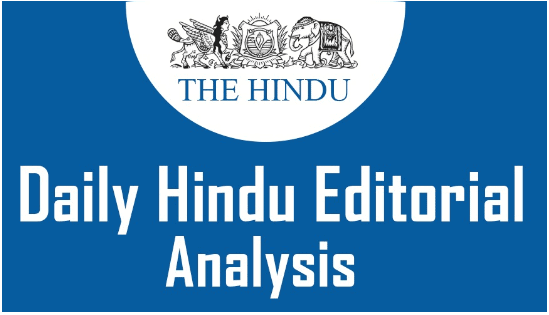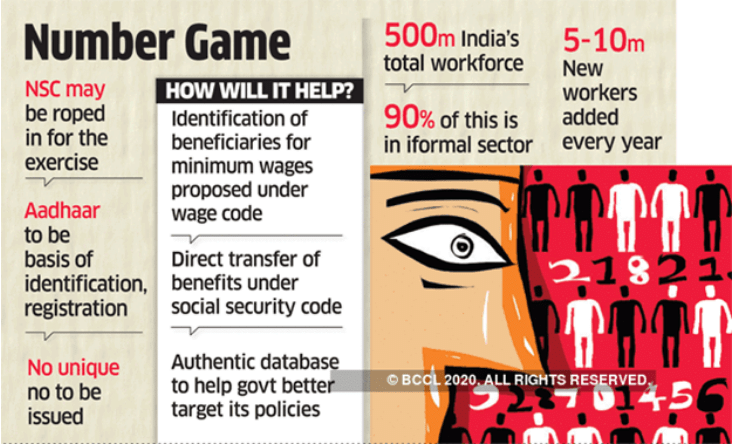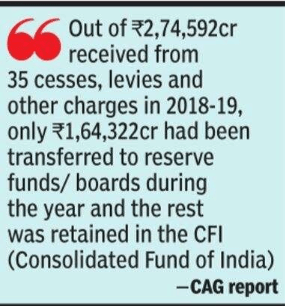The Hindu Editorial Analysis- 26th Sept, 2020 | Additional Study Material for UPSC PDF Download

1. CODE DEBATE: ON NEW LABOUR BILLS-
GS 2- Government policies and interventions for development in various sectors
Context
(i) Some laws are far too important and have far too much impact on the people to be passed in haste(hurry) or without sufficient deliberation.
(ii) The three codes aimed at consolidating(strengthening) diverse labour laws and ushering in reforms fall in this category.

Absence Of Scrutiny
(i) The codes were passed in both Houses after a limited debate and in the absence of the Opposition.
(ii) The Industrial Relations Code, the Social Security Code and the Occupational Safety, Health and Working Conditions Code, 2020, are an updated version of the respective Codes of 2019, which were scrutinised(examined) by a Standing Committee.
(iii) Therefore, there is considerable merit in the argument that the fresh drafts, introduced a few days before their passage, ought to have been sent back to the panel for an assessment.
(iv) It is significant that the most contentious(concerning) feature — the increase in the threshold for an establishment to seek government permission before closure, lay-off or retrenchment(reduction) from units that employ 100 workers to 300 — was not found in the 2019 draft, but has been introduced now.
(v) This gives establishments greater freedom in their termination and exit decisions.
(vi) No one disagrees with the basic objective of amalgamating(unifying), simplifying and rationalising labour laws.
(vii) However, the very fact that it involves a voluminous body of legislation should have meant that the final version was widely discussed with the stakeholders, and given sufficient time and opportunity to give their views.
Not In Interest Of Workers
(i) The root of the idea of consolidated labour codes goes back to the June 2002 report of the Second National Commission on Labour.
(ii) The broad vision has been to give an impetus(push) to economic activity without adversely affecting the interests of workers.
(iii) Whether this is adequately reflected in the new provisions will be tested by the experience of administering the Codes.
(iv) A positive feature is that the Social Security Code promises the establishment of social security funds for unorganised workers, as well as gig and platform workers, and also says their welfare would be addressed by the National Social Security Board.
(v) A contentious section allows the appropriate government to exempt any new factory from all provisions of the Code on occupational health, safety and working conditions.
(vi) The threshold for considering any premises as a factory has also been raised from 10 to 20 workers without the use of power, and from 20 to 40 with power.
(vii) It is significant that almost all major trade unions are opposing the new codes.
(viii) This reflects a genuine fear that expansive powers of exemption have been conferred on the respective governments and there has been excessive delegation of rule-making powers.
(ix) The threshold for lay-offs, as well as for various social security schemes can be raised by executive order; safety standards can be changed.
(x) There is much reason to fear that conferring wide discretion to the central and State governments may not be conducive to the interests of workers.
Conclusion
Far-reaching in effect, the new labour codes require greater deliberation.
2. CESS POOL: ON CAG REPORT OF CENTRE'S ACCOUNTS-
GS 2- Important aspects of governance, transparency and accountability
Context
The latest audit of the Union Government’s accounts tabled in Parliament this week reveals that the Finance Ministry quietly retained over 40% of all cess(tax on tax) collections in 2018-19 in the Consolidated Fund of India (CFI).

Lack Of Accountability
(i) As many as 35 different cesses, levies and charges yielded ₹2.75-lakh crore in the year, but just around ₹1.64-lakh crore was remitted to the specific reserve funds for which these cesses were levied.
(ii) This understated India’s revenue and fiscal deficit numbers.
(iii) It also meant that the purposes for which Parliament approved such cesses — be it health, education or infrastructure development — were not met.
(iv) The CAG of India has, not for the first time, urged the Finance Ministry to take immediate corrective action.
(v) Over 10 years, not a paisa of the ₹1.25-lakh crore of cess collected on crude oil was transferred to an oil industry development body it was meant to finance.
(vi) Part of the hefty(huge) cess collected as additional excise duties on petrol and diesel, ostensibly(apparently) to finance roads and infrastructure, was similarly retained in the CFI.
(vii) The GST Compensation Cess, over which the Centre and several States have now locked horns(had issues), was not spared either, with ₹47,272 crore not remitted to its rightful account over the first two years of GST.
(viii) Worse, compensation cess transfers to States were accounted as Grants-in-aid to States, distorting(affecting) the Centre-States fiscal math.
NEED TRANSPARENCY
(i) A new 4% Health and Education Cess on income tax was partly deployed towards education, but no fund was created for health. Ditto with a Social Welfare surcharge levied on customs.
(ii) None of these lapses can be considered inadvertent(unintentional).
(iii) It is no secret that the Centre’s reliance on cesses and surcharges to raise revenue has increased significantly since the States’s share of the divisible pool of taxes was raised to 42% in line with the 14th Finance Commission’s suggestions.
(iv) Cess receipts are not part of this pool and though it is arguable whether such levies are in sync with a nation trying to simplify its tax regime, their intended use to fund specific public spending needs serves as an acceptable rationale, provided it is adhered to.
(v) With a climate of distrust hovering over India’s federal polity — be it over the GST compensation dispute or the passage of Farm sector Bills without taking States on board — it is critical for the Centre to rebuild bridges.
(vi) Cesses, starting with the excise duties on petrol and diesel, need to be rationalised, even if just to provide succour(relief) to a citizenry.
(vii) Finally, absolute transparency is needed in the management of cess receipts so that Parliament and the people do not need to wait for audit findings to learn of this subterfuge(deceit).
Conclusion
The Centre must keep the faith of Parliament, States and the people, and stop misusing cess.
3. THE DOHA-KABUL JOURNEY AS A ROAD TO NOWHERE-
GS 2- Bilateral agreements involving India and/or affecting India’s interests
Context
(i) Finally, after numerous false starts, the representatives of the Afghan government and the Taliban could meet in Doha recently.
(ii) It was a tough road from Kabul to Doha for all three actors involved — the Afghan government, the Taliban, and, most importantly, the United States.
(iii) Now, that they have met in Doha, the road back to Kabul will be more challenging, given the inherent(existing) differences on the Afghan endgame among these three actors.


Some Red Flags
(i) Abdullah Abdullah is the chairperson of Afghanistan’s High Council for National Reconciliation and overseeing the government’s peace efforts and Mullah Ghani Baradar is the Taliban’s deputy leader.
(ii) First, as one could observe from the statements made by Abdullah Abdullah and Mullah Ghani, their endgame in Afghanistan appears substantially different, and even contradictory.
(iii) Abdullah Abdullah was referring to an Afghanistan with democracy as the basis, with liberal values and equal rights for everyone, including the minorities and women.
(iv) Mullah Baradar’s position is more straightforward: an Islamic emirate in Afghanistan.
(v) Keeping the theological(religious) and theoretical assumptions of a democracy and an emirate away, do these two representatives refer to something that means the same Afghan endgame?
(vi) Are there at least complementarities in what each wants to achieve, and how they see the future of Afghanistan?
(vii) Unfortunately, given history, the Taliban’s version of an Islamic emirate will be in direct contradiction to what the Afghan government wants in terms of democracy, human rights and equal rights for women and minorities.
(viii) Striking a middle ground may be difficult, even impossible. Furthermore, this would be a deal-breaker.
Exit America
(i) Second, how involved will the U.S. be once intra-Afghan talks take shape? The U.S. endgame in Afghanistan is not aimed at a political settlement in and for Kabul.
(ii) Instead, the U.S. looks at an exit from Afghanistan, as early as possible, preferably before the forthcoming U.S. presidential elections.
(iii) The U.S. should remain committed to the intra-Afghan process and ensure both sides, especially the Taliban, sticks to the political plot.
(iv) Unfortunately, the U.S. will not. U.S. President Donald Trump will declare an American victory in Afghanistan in the next few weeks.
(v) He would state the following as the American achievements: The al-Qaeda in Afghanistan is neutralised, the Taliban has severed(cut) its relationship with all external actors, the killing of Osama bin Laden, elections and democracy in Afghanistan, and, finally, an intra-Afghan dialogue.
(vi) Topmost on his achievement list would be the job done in Afghanistan, announcing the withdrawal of all American troops, before Christmas or the New Year.
(vii) After West Asia, Afghanistan would be Mr. Trump’s major achievement.
False Victory
(i) Third, the American exit from Afghanistan – physically and politically, would rupture(harm) the intra-Afghan dialogue process.
(ii) The Afghan government has not only been reluctant from the beginning to engage with the Taliban but is also divided within in terms of how it sees the Taliban.
(iii) While leaders like Abdullah Abdullah and Amrullah Saleh (Afghanistan Vice-President) are on the extreme side in terms of how they would loathe sharing power with the Taliban, others including President Ashraf Ghani would have reservations.
(iv) The Afghan leadership was pressurised by the U.S. and even threatened with an aid cut, to get on to the road to Doha.
(v) The Loya Jirga(platform to discuss) that the Afghan government organised recently on the subject was under American pressure, to create a consensus in starting a dialogue with the Taliban.
(vi) This is what the Afghan Peace Council has been tasked to and has been grappling with — to find an answer and a middle ground.
(vii) Outside the Afghan government, there reservations among multiple sections – the minorities and women.
(viii) The last few years and elections have created certain institutions of democracy and liberal notions that make many Afghans look at their future beyond the tribal and religious orders.
(ix) For them, negotiating with the Taliban and reaching a middle ground will be a tough assignment.
The Taliban Spells Violence
(i) Fourth, what does the Taliban want? Is it looking forward to sharing power in Kabul and taking part in an electoral process?
(ii) Is it looking forward to working with the Afghan institutions and abiding(following) by the legislation and parliamentary norms?
(iii) Is it looking at creating an equal and egalitarian(equality) society in Afghanistan?
(iv) There is an element of naiveté(innocence) among those who believe that the Taliban is transformed and will find middle ground with the Afghan government.
(v) For the Taliban, it would be nothing short of an Islamic Emirate of Afghanistan. Period.
(vi) Fifth, the Taliban has been waiting for the last two decades for international troops to leave. It would wait for a few more months to see the last American soldier exit Afghanistan.
(vii) Then, it would return to what it knows the best — violence.
(viii) Aimed at three actors (the international troops, the Afghan government and the Afghan people), the Taliban has been employing violence as the primary strategy to achieve what it has wanted.
(ix) Despite the February 2020 agreement with the U.S. in Doha, the Taliban never stopped from using violence.
(x) Available data would suggest that there has been no let-up in violence since February 2020, and in the process, the Taliban has got what it has wanted: the release of all Taliban prisoners.
(xi) Once the Americans leave, it would go back to the strategy that has yielded maximum dividends — violence.
(xii) As one could observe during the last week, violence continues today, even during the post-Doha meeting between the two actors.
(xiii) Also, until now, it has not agreed to a ceasefire; it will not in the near future.
The Regional Game
(i) Sixth, the return of the regional great game.
(ii) Pakistan, Iran, China, Russia and India all have stakes in Afghanistan, and have made it clear through the multiple dialogues on Afghanistan (bilateral, trilateral and quadrilateral).
(iii) As long as American troops and interests remain in Afghanistan, their role would remain limited.
(iv) Now, one should wait and watch on how the regional great game in Afghanistan is played, and how it has shaped the Afghan endgame.
(v) The last point would be how history would judge the American intervention in Afghanistan in the last two decades.
(vi) Is the U.S. leaving Afghanistan in 2020 any better than how it saw it when it invaded the country in 2001? Or has it made the situation worse?
Conclusion
(i) To conclude, if the road from Kabul to Doha was tough, the return would be even tougher and more complicated.
(ii) It is also possible that the Doha-Kabul journey could be a road to nowhere.
|
21 videos|562 docs|160 tests
|
FAQs on The Hindu Editorial Analysis- 26th Sept, 2020 - Additional Study Material for UPSC
| 1. What is the significance of analyzing The Hindu editorials for UPSC exam preparation? |  |
| 2. How can reading The Hindu editorials help in UPSC exam preparation? |  |
| 3. What are the key points to consider while analyzing The Hindu editorials for UPSC preparation? |  |
| 4. How can one effectively analyze The Hindu editorials for UPSC exam preparation? |  |
| 5. Are there any specific strategies to follow while analyzing The Hindu editorials for UPSC exam preparation? |  |
















